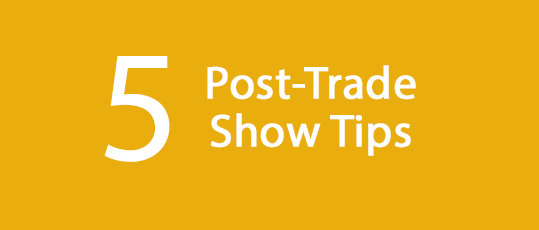5 Tips for Trade Show Follow-Up & Evaluation

5 Tips for Trade Show Follow-Up & Evaluation
As any experienced trade show exhibitor knows, the work doesn’t end after the convention hall doors have closed. In fact, some may argue that the real trade show work begins after the trade show is over. Exhibiting at the trade show is the easiest part. Its the effort, time and creation of new ideas that comes with trade show follow-up and evaluation that is difficult. Is your trade show team ready to handle the pressure?
Here are five trade show tips for giving your team a jump-start on trade show follow-up and evaluation.
Trade Show Follow-Up & Evaluation
Since we already wrote a post about trade show lead follow-up we won’t go into much detail about it, but after a trade show it is important that your team begin calling trade show leads right away. Not tomorrow; not next week; today. The faster your team works to contact each lead, the better your ROI. If your team is not immediately following up with trade show leads, why are you exhibiting in the first place?
Great, now that that’s out of the way – let’s get to the meat of this article.
1. Organize Your Trade Show Leads
One of the most beneficial tips, that will save your trade show team a lot of time and energy in the long run, is training your trade show event staff to organize each trade show lead as it is collected. Prior to the trade show, have a meeting with your team where you create a lead hierarchy. Create concrete examples of what a hot, medium, and cold trade show lead means to your brand. Then, encourage all trade show event staff to follow those guidelines.
By doing this, you are effectively organizing your trade show leads into different categories and making it easier for the sales team to create strategies for targeting each lead group. The easier it is for your sales team to target, the higher their close rate, and the more revenue is produced.
2. Search Engine Optimization
Despite Search Engine Optimization (SEO) being an important aspect for constant company improvement, the time period after a trade show is imperative for companies who want to be easily found online. This means that when your company is preparing for a trade show or exhibiting at the event, the online marketing team should be focused on creating a strategy that builds your brand’s SEO for keywords sounding the trade show. If your brand isn’t ranking for trade show related keywords that attendees are searching for before, during, and after the trade show, then your brand is losing out valuable, free revenue.
Remember, attendees meet a lot of exhibitors at each trade show so unless your team did something exceptionally memorable, it is unlikely that they will remember your specific brand name after the trade show. Instead, your marketing team must create content that associates your brand with the name of trade show and industry so that your website will appear in attendee searches.
Write a blog and share it on Twitter and Linkedin using the event hashtag, share your product demonstration video on YouTube, share your PowerPoint slides on SlideShare, connect with attendees on Linkedin, share your trade show experience in a LinkedIn group specific to that trade show, etc.
2. Keep the Social Buzz Going
Following the trade show, attendees will be searching the web and social media outlets to learn more about the exciting brands they discovered at the event. Therefore, your brand should have a strong presence on all media platforms including Twitter, Facebook, and LinkedIn. This social media blast will give your company an advantage over competition by standing out to consumers who are looking for the right brand.
Attendees that didn’t get a chance to learn about your product and services can look to social media to search for products and services. In order for your brand to be found, all of the social media posts your team creates should include the event hashtag and should include the trade show’s handle.
Do whatever you can to make sure that your brand name becomes associated with the trade show and continue doing it. Don’t stop because the trade show is over, keep tweeting, keep sharing, keep the conversation going and invite others to do the same. Consider teaming up with the trade show organizer and hosting a post-trade show game that encourages attendees to share their favorite trade show memories. Check out this blog for more tips on using social media at trade shows.
4. Collect Feedback
Another important thing to remember after the trade show is to collect feedback about your company’s performance at the show, the success of the booth design, and productivity of the staff hired for your company. Feedback is a company’s greatest tool for improving ROI and sales at the next big event.
A great resource for collecting feedback is the trade show event staff that worked the event because they have first-hand knowledge regarding input from customers. They will have a better understanding of the strengths and weaknesses of your strategy and have tips for making improvements. Encourage anyone submitting feedback to be as honest as possible. What worked? What didn’t? After all, collective criticism is the best way to improve your brand for future trade shows.
5. Archive Content
Finally, document all activity from before, during, and after the trade show. Include the names and costs of all of the vendors you worked with, the strengths and weaknesses of the show, the feedback your team provided, possible leads developed, and any other pertinent information. Keeping records of past trade shows will allow your company to continue to grow and make beneficial changes for the success of your future trade shows.

